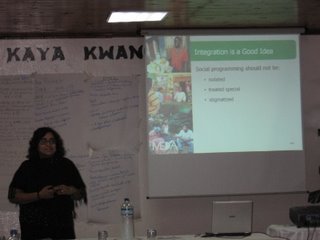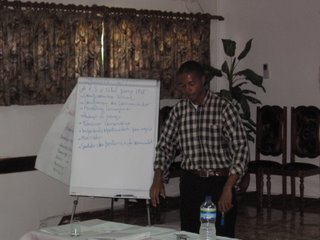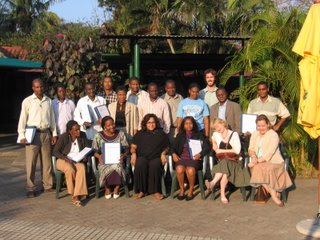The Taking of Xefina Island
A few kilometers off the coast from Maputo lies the tantalizing and enigmatic island of Xefina (sha fee nah). For months my friends and I have been starring across the Maputo Bay wondering how we could explore this island and working up the confidence and energy to make the journey. Last week we finally transformed our dream into a reality. We organized a group of 20 strong adventurers, comprised of Brits, Irish, French, Brazilians, Argentines and a lone Canadian, and set off for a weekend excursion to “colonize” the largely uninhabited island.
Our mode of transport would be a small fishing boat that we hired from some local fishermen who would take us across the bay and guide us throughout the island. The plan was simple enough. We were to arrive at Costa Do Sol at 12:00 on Saturday and the boat would make two trips across the bay with all of our gear and crew. When we were all assembled at the beach that afternoon the sea was at its complete low tide, requiring us to walk about two kilometers out into the ocean on the exposed sand bars in order to meet up with the boat.
The first group was taken across without incident while the second group, which included myself and the majority of the tents, food, booze and instruments, waited patiently on the other side. Suddenly, as if someone flicked on a light switch, the wind became quite violent, stirring up the sea with great force and bringing in the tide at a rapid pace. We were forced to flee back to the shore in order to stay dry. We waited and waited for the boat that never returned, frantically trying to work out a plan B for getting across to our friends stranded on the other side without tents or food.

Finally, one of the fishermen came running down the road telling us that we had to walk 5 km up to another point along the shore where it would be easier to navigate the boat through the intense wind. The sand from the beach continued to pummel us like Bedouins in the Sahara as we reached our departure spot and assessed our situation. We had a rickety little fishing boat to take us, along with our piles of supplies, across an increasingly violent and menacing sea. The situation looked perilous and spirits were beginning to sink faster than the Titanic (not a very encouraging image).
Throwing caution into the wind, we climbed aboard the vessel and within no time got completely drenched from the pounding waves. We each took turns bailing out the boat and sharing the one rain jacket that brought momentary warmth. Freezing cold and examining our waterlogged supplies, we had nothing to do but repeatedly sing uplifting songs to the likes of “here we come Xefina!!” spurred on by our energetic captain. We arrived at the island’s main fishing village, home to Xefina’s 50-60 permanent residents, and were greeted by the strange and almost ghost like locals. Our arrival must have been a huge surprise to them as VERY few white folks make it across to the island.
The environment of Xefina can be described as a combination of the eerie and bizarre. Walking across the island we came across the ruins of the old Portuguese jail that was used up to 1975 to incarcerate political prisoners or any Mozambican deemed to be a threat to the colonial state. In this respect, Xefina can be seen as the Mozambican Robben Island. Many of the prisoners that were sent to this island were never heard from again, feeding the rumours of the terrible dungeons and torture chambers that lay beneath the complex. In addition to serving as a penal island, Xefina also was home to leper colony during the colonial period, further contributing to the overwhelming feeling of “restless souls” roaming the island.

When we arrived at the opposite side of the island we were once again confronted by the gale force winds and the realization that we could not find our campsite. Shivering madly in our wet clothes, and without cell phone reception, low spirits began to slowly turn into panic and fear. One of our guides and I went out on a reconnaissance mission, tearing through the thorny bush and eventually, to our extreme relief, hearing the calls of the search party from the first group. After a joyous reunion with our other friends, we trekked on to our campsite where the promise of fire, food and alcohol quickly revived our ailing spirits.

Our campsite soon came to life with the preparation of our BBQ feast, the sharing of wine and other “island concoctions,” the singing of campfire choruses and the camaraderie that was fashioned out of the trials of the day’s journey. After midnight we all went for a moonlight stroll along the beach to explore the ruins of the enormous batteries built by the Portuguese to defend Maputo Bay during the first and second world wars. These massive cannons and lookout towers are now completely in ruins and are crumbling into the sea. Walking amongst these ruined monuments of war, under the clear light of a full moon, was one of the most surreal experiences of my life.

We awoke the next day to an island paradise, an entirely different world to the one that we arrived at only the night before. The beaches were pristine, the water cool and soothing and we had a spectacular view of Maputo City. After a lazy breakfast on the beach, we set off once again to explore the batteries and take pictures of this most bizarre spectacle. We felt as if we were walking around in a Salvador Dali painting. We also came across a munitions building that still housed over 200 rusted bombs once intended for the massive cannons. Walking around that place gave us all a seriously creepy feeling.

Later that afternoon we met up with our fishermen guides and we all piled into the one boat for our return to Maputo. This time the sea was like a sheet of glass, a night and day contrast from our previous trip over to the island. Arriving exhausted but altogether grateful for the experience, we agreed that “colonizing” Xefina had certainly been more difficult and demanding then we had anticipated. The island however, definitely left its mark on all of us. Undoubtedly, one of the most incredible yet strange experiences of my time thus far here in Mozambique









